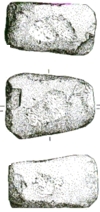

Pen Cerrig y Mwyn, Nantymwyn Lead Mine, Llandovery, South Wales [SN 789 443]
Nantymwyn was the largest metal mine in Southern Wales and has a documented history dating back to at least 1530. The oldest workings appear to straddle the quartz ridge of Pen Cerrig y Mwyn, but little is known about them.
In 1996 the EMRG carried out a ground survey of the mining remains and early hushing activity in this area.
The remains were examined archaeologically and we discovered one of several small
hollows in the side of the ridge believed to have been excavated by fire setting
-

A much earlier phase of hushing consisting of a narrow leat following the top of the ridge with release channels either side of it was looked at in 2002. The buried peat infill representing the abandonment of this channel was dated to between 520 and 620 yrs AD, suggesting that the original use of this probably dates to the Roman period or before (Timberlake 2003b).
Given the proximity of the Roman gold mine at Dolaucothi and the extensive series of associated leats for hushing on the nearby Mallaen Mountain, it seems possible that Roman interest in this promising quartz vein on the Pen Cerrig was part of a strategy to prospect for gold within the surrounding area.
![]()
![]()
This website was made possible by a grant from the Cambrian Archaeology Association

A particularly early medieval radiocarbon date (865 – 1035 yrs cal AD) was obtained from charcoal associated with this, and it seems that the working was for lead.
Schematic plan showing hushing activity and investigation sites (S. Timberlake and B. Craddock)
